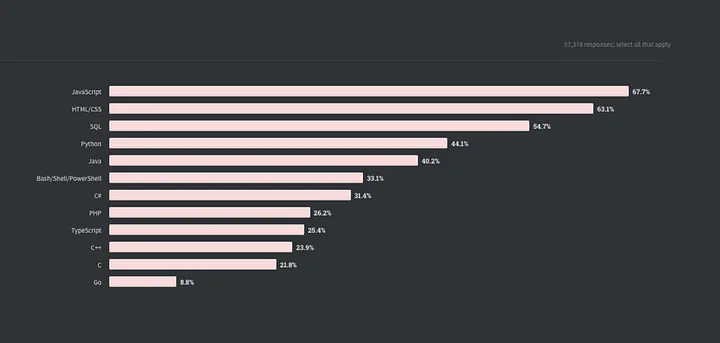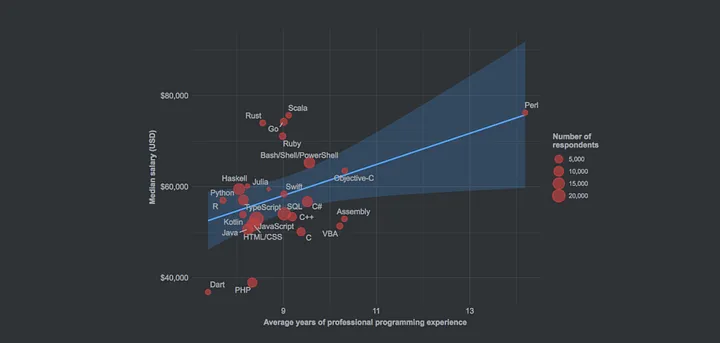- Python vs JavaScript: What to Choose in 2023
- What is JavaScript?
- What is Python?
- JS vs Python: Popularity
- JavaScript vs Python: Speed and Performance
- JavaScript vs Python: Learning Curve
- JS vs Python: Web and Mobile Development
- Advantages of Python:
- Applications of Python:
- Advantages of JavaScript:
- Applications of JavaScript:
- Final Thoughts
- Быстрее ли JavaScript, чем Python?
Python vs JavaScript: What to Choose in 2023
The software development industry is dynamic and volatile. People who have been engaged in software development for at least a few years have seen a large pile of changes. Some technologies have entered the competition by storm and acquired popularity in a dramatically short period of time like Python, and some have gone forever without much acknowledgment like Pascal. Therefore at the beginning of one’s career path, it’s of great importance to choose the language that is in demand, widely applied, and has an extensive community.
As a software development company, we take a big interest in programming languages. In today’s blog, we will cover the matters of Python vs JavaScript, the languages that are in some ways comparable but with significantly different use cases and syntax.
What is JavaScript?
JavaScript is one of the most popular scripting languages initially created to “make web pages more interactive”. When something more is happening on the web page than just its static display, for instance, animating 2D/3D graphics, interactive maps, or scrolling a video in a player, most likely it’s because JavaScript has been involved. It’s an object-oriented language whose functionality builds on top of what CSS and HTML provide.
What is Python?
Python is an object-oriented, general-purpose programming language that is gaining popularity at extremely high speed. The main principle behind Python is the readability and DRY (Don’t Repeat Yourself) concept. Python has an easy-to-learn syntax, therefore, reduces the expenses for program maintenance. It incorporates dynamic typing and binding and high-level data structures which makes it extremely useful for complex application development.
JS vs Python: Popularity
According to StackOverflow Developer Survey 2021, JavaScript has maintained its leadership as the most commonly used programming language for the eighth year in a row. Python holds fourth place in the list having beaten such technologies as Java, PHP, and C#.
The PYPL (Popularity of Programming Language index) as of February 2022, states that Python remains the most popular programming language, while JavaScript takes the third position. The index is based on the number of tutorials that are searched on Google. So, if you trust in collective judgment, the PYPL index can help you to choose which language to master or to take up for project development.
According to the TIOBE Programming Community index, Python has swapped positions with Java that was taking its position for 20 years in a row, and C, and now takes first place among the most popular programming languages. JavaScript is placed in the seventh position. TIOBE index is based on a number of skilled engineers around the world, courses, and third-party vendors.
As to the salary comparison, Indeed states that the average salary of a Python developer is $51 per hour in the US, while a JavaScript developer earns $48 correspondingly.
Another data provided by StackOverflow states that Python programmers earn approximately $116k annually, while JavaScript developers make around $110k.
JavaScript vs Python: Speed and Performance
The initial purpose of creating JavaScript was to make it fast on the web. Compared to Python, it’s a little bit faster since Node.js, for example, offers advanced multithreading while Python processes requests in a single flow. Apps that require real-time and dynamic interactions are more frequently built on JavaScript and the same can be told about website and ERP apps (as JS supports both domains). This means that applications like Facebook that generate big amounts of data in real-time are more likely to use JavaScript so as not to make their users wait.
On the other hand, Python is a perfect choice for CPU-intensive solutions such as a machine learning model that has to process large piles of data to solve a specific problem. Since it’s easy to code, it’s frequently used to develop large-sized applications, especially math-intensive projects. Though the Instagram server is more of an I/O than a CPU-intensive situation, it still uses Python. This proves that Python can perform very quickly if you know how to optimize it correctly (with the help of NumPy or Cython, for example).
JavaScript vs Python: Learning Curve
Beginners are usually tempted to start with Python as it’s considered one of the most beginner-friendly languages, and there are a few reasons for that. First of all, code in Python is more readable compared to other languages and contains fewer lines. Secondly, it has fewer structural rules which significantly speeds up the development process. JavaScript is not that easy to learn and is quite difficult to debug. Though, if one is acquainted with C-like languages, it will be easier to learn JavaScript as its syntax is similar to the rules of these languages.
There is a massive amount of resources available on the Internet in both languages. If you want to take up Python, a good idea is to check Jose Portilla’s The Python 3 BootCamp which has almost one million graduates.
JS vs Python: Web and Mobile Development
As has been mentioned above, web applications developed with JavaScript are faster and handle big amounts of data and code better while Python will take longer to respond. Thanks to Node.js which supports asynchronous programming, programmers can reach better scalability using JS. On the other hand, Python is more used on the server-side. It’s important to mention that Python has a steady environment with the following frameworks: Pyramid, Flask, and Django, using which will improve the development.
Initially, Python was not designed to develop GUI apps though with the help of such frameworks as Kivy and BeeWare libraries, it’s possible to build native-looking mobile apps with Python. Though the primary purpose of JavaScript was the development and management of websites, it’s also frequently used for mobile development. A big drawback of JS for mobile is that neither IOS nor Android run native apps written with it.
Advantages of Python:
- Python is a high-level programming language that is easy to learn, read, and write;
- Being an interpreted language, Python executes the code line by line;
- It has massive library support, including PyPl;
- Python is a very productive and flexible programming language;
- It’s a general-purpose programming language, therefore, is applicable to almost every field and variety of tasks.
Applications of Python:
Python has a wide range of use cases across different industries. Besides the common applications such as building mobile, web, and desktop applications, Python is a good choice for:
- AI and ML projects;
- Data science;
- Scripting;
- Database programming;
- Quick prototyping, etc.
Advantages of JavaScript:
- JavaScript is an interpreted language and a client-side script that reduces the compilation time and speeds up the execution of the program;
- It’s easy to understand and learn;
- JavaScript is highly interoperable and perfectly works with other programming languages;
- It can create rich interfaces with such features as drag and drop, components like sliders, etc.;
- It’s extremely popular and is used everywhere on the web and increasingly used on the backend with the advent of Node.js.
Applications of JavaScript:
Having the largest open-source package repository, JavaScript has been used for every type of software in different segments:
- Web, mobile, and desktop applications;
- Server applications;
- Games;
- Smartwatch apps;
- Web servers;
- Flying robots, etc.
Final Thoughts
Summing up, both languages are very popular and offer a lot of job opportunities and high rates in the market. There are a lot of online courses and plenty of documentation to take up each of them. JavaScript strongly holds the position of the most powerful language for web and mobile development, while Python dominates in the machine learning field because of its capacity to manipulate data and strong readability. The choice between them also depends on your previous experience. If you want a quick start, Python is a better option. Though people with knowledge of C-like languages won’t find JavaScript a big challenge either.
Which language would you recommend for beginners? Share in the comments below.
Быстрее ли JavaScript, чем Python?
Множество постов я видел, где люди писали про преимущество JavaScript в скорости перед Python. Много раз мне это писали мои знакомые. Ну что же, пришло время это проверить.
P.S. В каждом коде я буду считать время его выполнения именно методами языков.
from time import time time()Также я всегда буду брать средние показатели скорость, полученные из 10 запусков программы.
Для начала проверим скорость обычного цикла for, который будет выводить числа от 1 до 1000.
start = Date.now() for (var i = 1; i < 1001; i++) < console.log(i); >end = Date.now() - start console.log(end + " ms")Выполнение кода заняло 850 ms.
from time import time start = time() for i in range(1, 1001): print(i) end = round(time() - start, 3) print(str(end) + " ms")Выполнение этого кода заняло 620 ms.
1:0 в пользу Python.
Теперь давайте сделаем то же самое, только вместо for у нас будет while.
start = Date.now() var i = 1; while (i < 1001) < console.log(i); i++; >end = Date.now() - start console.log(end + " ms") 760 ms у нас даёт JS. Быстрее чем for, кстати.
from time import time start = time() i = 1 while i < 1001: print(i) i += 1 end = round(time() - start, 3) print(str(end) + " ms") Если JavaScript стабильно держится на показателе около 750-760 ms, то скорость Python'а колеблется от 600 ms до 750 ms. Но в итоге средняя скорость выходит в 720 ms.
Следующие в очереди — функции.
Создадим функцию, которая будет возводить число 123 в степень 123. Почему не больше? Это я объясню позже. Сейчас же просто создадим такие вот функции.
start = Date.now() function func(a,b) < console.log(a ** b); >func(123, 123); end = Date.now() - start console.log(end + " ms")JavaScript выполняется за 10 ms.
from time import time start = time() def func(a, b): print(a ** b) func(123, 123) end = round(time() - start, 3) print(str(end) + " ms")Этот код выполняется за 1 ms. В 10 раз быстрее чем JavaScript…
Это всё были детские игры! Давайте играть по-взрослому!
start = Date.now() for (var i = 1; i < 1001; i++) < if (i % 5 == 0) < console.log(i ** 10) >else < console.log(i ** 123) >> end = Date.now() - start console.log(end + " ms") Код выполняется за 800 ms.
from time import time start = time() for i in range(1, 1001): if i % 5 == 0: print(i ** 10) else: print(i ** 123) end = round(time() - start, 3) print(str(end) + " ms") Python-код выполнялся 1300 ms.
«Вот она, победа JavaScript! Python не может в сложные вычисления!» — сказал бы я, если бы не одно НО. В большинстве случаев, JavaScript даже не считает. Он просто выводит «Infinity» и продолжает, а Python считает всё. И вот я даже не знаю, кому присудить победу. Наверное, здесь у нас будет ничья.
Подведём итог: Python оказался быстрее JavaScript в циклах, функциях, вычислениях. Он считает всё, когда JavaScript делать этого не хочет.
Этим постом я не пытался принизить JavaScript, сам его люблю всем сердцем. Просто надоели те, кто везде пишут: «Python самый медленный! Нафиг такую скорость!»
Спасибо за уделенное время. Удачи всем!


